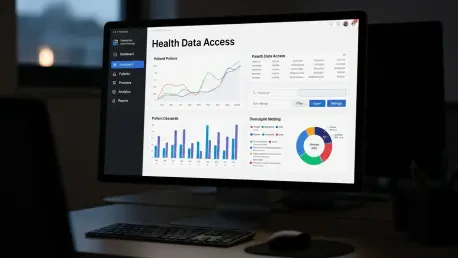Picture a nation entering the peak of respiratory illness season, with flu, COVID-19, and RSV cases on the rise, only to find that the primary federal agency tasked with tracking these threats is shuttered, leaving public health officials across the United States in a dire situation. This alarming scenario is the reality faced due to a federal government shutdown. The Centers for Disease Control and Prevention (CDC) has halted vital operations, leaving states scrambling to monitor disease outbreaks without federal dashboards or expert guidance. This roundup gathers perspectives from various health experts and state officials to explore the depth of this crisis, the disparities in state responses, and the potential risks to community safety. By synthesizing these insights, the aim is to shed light on the immediate challenges and long-term implications of this data blackout.
Understanding the Crisis: Federal Shutdown and Public Health
The Ripple Effect of CDC’s Operational Halt
The shutdown of federal operations has directly impacted the CDC, suspending critical tools like disease tracking dashboards and expert analysis that states rely on for early outbreak detection. Many health professionals emphasize that this disruption creates a significant void in national surveillance efforts. Without centralized data, the ability to predict and respond to emerging health threats is severely compromised, especially during a time when respiratory illnesses typically surge.
Beyond the immediate loss of data, the timing of this shutdown adds another layer of concern. Experts in public health stress that the overlap with the start of flu season amplifies the urgency to maintain robust monitoring systems. The absence of federal support means that state health departments must navigate uncharted territory, often without the resources or expertise to fill the gap left by the CDC.
Why This Matters Now More Than Ever
Public health leaders point out that the current season is a critical period for tracking infectious diseases, as community transmission rates often spike. The lack of federal coordination could delay the identification of outbreaks, putting vulnerable populations at greater risk. Several officials have highlighted that this data drought comes at a time when public trust in health systems is already strained, further complicating efforts to encourage preventive measures like vaccination.
This crisis also raises broader questions about national health security. Many in the field argue that the inability to access real-time data hampers not only immediate responses but also long-term planning for pandemics or seasonal epidemics. The consensus among experts is that this situation underscores the fragility of a system heavily dependent on federal infrastructure.
State Responses: A Patchwork of Preparedness
Independent Surveillance vs. Federal Dependence
Across the country, states exhibit a wide range of capabilities in handling disease surveillance without federal assistance. Some regions, particularly those with established independent systems like Texas and North Carolina, report minimal disruption in updating key metrics. Health officials from these areas note that their local programs allow for continued monitoring of certain diseases, though gaps remain in accessing comprehensive federal updates on specific metrics like mortality rates.
In contrast, other states find themselves in a precarious position, unable to sustain surveillance efforts without CDC data. For instance, regions like Georgia have had to pause reporting on influenza due to the absence of federal input. Experts in state health policy warn that this disparity creates a fragmented national response, where some communities may receive timely warnings while others remain in the dark about looming health threats.
The uneven ground in state preparedness has sparked debate among professionals about the need for greater investment in local infrastructure. While some advocate for self-reliance as a buffer against future disruptions, others caution that without federal coordination, the risk of missing significant outbreaks grows exponentially, especially in under-resourced areas.
Wastewater Surveillance: A Critical Tool at Risk
Wastewater data has emerged as a cornerstone of early outbreak detection, offering insights into community transmission before clinical cases are reported. However, the federal shutdown has rendered many CDC-maintained dashboards inaccessible, leaving states to fend for themselves. Public health analysts note that while certain states maintain independent wastewater monitoring, others face a complete blackout, unable to access this vital early warning system.
Regional variations further complicate the picture. Some areas have forged partnerships with local universities or health departments to interpret available data, showcasing innovative adaptations. Yet, many experts express concern over the sustainability of these efforts without federal oversight, questioning whether localized solutions can adequately replace the comprehensive analysis provided by national systems.
The broader implication, as highlighted by numerous health researchers, is the potential for unseen outbreaks to spiral out of control. The loss of a unified wastewater surveillance network could delay critical interventions, such as public advisories or resource allocation, ultimately endangering lives in communities with limited visibility into transmission trends.
Vaccine Hesitancy Amplified by Data Gaps
Another pressing issue exacerbated by the shutdown is the challenge of declining vaccination rates, particularly among children, amid rising misinformation. Public health advocates emphasize that without access to detailed disease data, crafting targeted vaccination campaigns becomes nearly impossible. The inability to pinpoint areas of high transmission or low immunization coverage hinders efforts to protect at-risk populations.
Several experts in epidemiology also point out that the current data void fuels public skepticism toward health interventions. When officials cannot provide concrete, real-time evidence of disease spread, convincing communities to take preventive actions becomes an uphill battle. This dynamic is especially troubling during a respiratory illness surge, when timely vaccination can mean the difference between containment and widespread outbreaks.
The intersection of data gaps and vaccine hesitancy reveals a deeper erosion of trust in public health systems. Many in the field argue that restoring access to reliable information is essential to rebuilding confidence and ensuring that communities are equipped to make informed decisions about their health and safety.
Lessons Learned and Broader Implications
Navigating a Fragmented Health Response
Reflecting on the current crisis, health policy analysts underscore the profound impact of the CDC’s operational halt on national disease monitoring. The loss of early warning systems has placed an uneven burden on state health departments, with some adapting through local resources while others struggle to keep pace. This fragmented response highlights the critical need for a cohesive federal-state partnership to maintain public health security.
A recurring theme among experts is the call for actionable solutions to mitigate such disruptions in the future. Recommendations include increased funding for state-level surveillance infrastructure to reduce dependence on federal systems. Additionally, fostering collaborations with academic institutions or private entities for data analysis could provide a safety net during times of federal inaction, ensuring continuity in monitoring efforts.
Building Resilience for the Future
Another key insight from this roundup is the importance of preparing for recurring disruptions. Many public health leaders advocate for a dual approach: strengthening local capabilities while advocating for robust federal support. The consensus is that a resilient public health system must balance state autonomy with national coordination to effectively address both seasonal and unexpected health threats.
Beyond infrastructure, there is a shared emphasis on public engagement as a tool for resilience. Experts suggest that individuals can play a role by staying informed through local health updates and prioritizing vaccinations, especially during periods of data scarcity. These personal actions, while small, contribute to broader community protection when systemic challenges arise.
Reflecting on a Critical Moment in Public Health
Looking back on the insights gathered, it is evident that the federal shutdown created unprecedented challenges for state health departments, exposing vulnerabilities in disease surveillance and response systems. The varied perspectives from experts and officials paint a picture of a nation grappling with fragmented capabilities, where the loss of federal data left some communities dangerously uninformed. The discussions around wastewater monitoring and vaccine hesitancy further illuminate the cascading effects of this crisis on public safety.
Moving forward, the focus must shift to actionable steps that prevent such disruptions from becoming a recurring threat. States are encouraged to invest in independent surveillance tools and build networks with local partners to ensure data continuity. At the national level, advocating for policies that safeguard CDC operations during shutdowns is imperative. For individuals, seeking out reliable local health resources and staying proactive with preventive measures can help bridge the gap until systemic solutions are in place. This moment serves as a stark reminder that a unified defense against disease requires preparation at every level, from personal actions to federal commitments.









